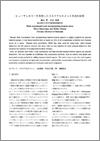ヒューマンエラーを考察したリスクアセスメント手法の研究、プラントヒューマンファクター学会、2009
| 森山哲、大谷英雄 |
| ヒューマンエラーを考察したリスクアセスメント手法の研究 |
| 日本プラントヒューマンファクター学会 |
| 2009, Vol.13, No.2 |
| リスクアセスメント、人的過誤、不安全行動、PSF、機械安全 |
| Though Risk Assessment tools incorporating human-related aspects is highly required for general industry people, it has been reported that as many as 80% of all occupational accidents have human errors as a cause. Human error probability (HEP) has been used for large-scale, safety-critical industries for last quarter century, but these tools are not suitable for more general industries that comprise the majority of occupational accident settings. Here, we describe and verify a risk assessment tool that includes human-related aspects for general industries. The tool expands on traditional risk assessment methods, such as matrix, risk graph and numerical scoring method, by adding human-related aspects. The tool is easy to use, fast and requires low resources in general occupational environments, and includes assessments of human behavior and potentially outdated machinery at work place and small companies. |
| 1. 初めに 2. 危害の発生と人的側面 2.1 リスクの概念 2.2 危害の発生 2.3 リスクの低減目標とヒューマンエラー 3. ヒューマンエラーと危険源 3.1 労災事故におけるヒューマンエラーの検討 3.2 ヒューマンエラーに影響を与える要因の抽出 3.3 人的側面の危険源リスト 3.4危険源の重複評価の回避と再定義 3.5 人的過誤率とPSF 4. リスクアセスメント手法への応用 4.1 ヒューマンエラーと危険事象の発生確率 4.2 リスクマトリックス法 4.3 リスクグラフ法 4.4 数値計算法 5. フィールドテスト 6. 結論と今後の課題 |
| (1) 安全衛生年鑑 平成17 年版, 中央労働災害防止協会 (2) ISO,2003, ISO 12100-1 Safety of machinery — Basic concepts, general principles for design —Part 1:Basic terminology, methodology. (3) ISO,2003, ISO 12100-2 Safety of machinery — Basic concepts, general principles for design — Part 2:Technical principles. (4) ISO, 1999, ISO 14121 Safety of machinery — Principles of risk assessment. (5) 危険性又は有害性等の調査等に関する指針, 平成18年3 月10 日, 厚生労働省労働基準局長, 基発第0310001 号 (6) Swain, A. D. and H. E. Guttmann (1983). Handbook of Human Reliability Analysis with Emphasis on Nuclear Power Plant Applications. NUREG/CR-1278. (7) 吉野賢治 (1996). “運転・保守作業におけるヒューマンエラー予測手法の確立 その1)ヒューマンエラー誘発要因としてのPSF の重要性とその構築.” 日本プラント・ヒューマンファクター学会誌 1(1): 8-15. (8) ISO (2007), ISO14121-1:2007 Safety of machinery – Risk assessment. (9) ISO (2007), ISO/TR14121-2:2007 Safety of machinery — Risk assessment — Part 2: Practical guidance and examples of methods. (10) Gertman, D, H. Blackman, et al. (2005). The SPAR-H Human Reliability Analysis Method. NUREG/CR-6883. (11) 橋本邦衛 (1990). 安全人間工学, 東京, 中央労働災害防止協会 (12) US Department of defense, 1993, MIL-STD-882C, System Safety Program Requirement (13) American National Standards Institute, 2000, ANSI B11.TR3:2000, ANSI Technical Report for Machine Tools – Risk assessment and risk reduction – A guide to estimate, evaluate and reduce risk associated with machine tools. (14) DIN V 19250 (1994). Basis safety evaluation of measuring and control protective equipment. (15) 永田学 and 行待武生 (2005). “ヒューマンエラー未然防止に向けた方策誘導マトリックスの導出.” ヒューマンファクターズ 10(1): 10. (16) 永田学 and 行待武生 (2005). “再発防止対策におけるPSF 緩和の評価とヒューマンエラー未然防止への提言.” ヒューマンファクターズ Vol.9(No.2): 9. (17) 行待武生 and 永田学 (2008). “ヒューマンエラーの防止対策誘導リストの研究.” ヒューマンファクターズ 13(1): 18. |















